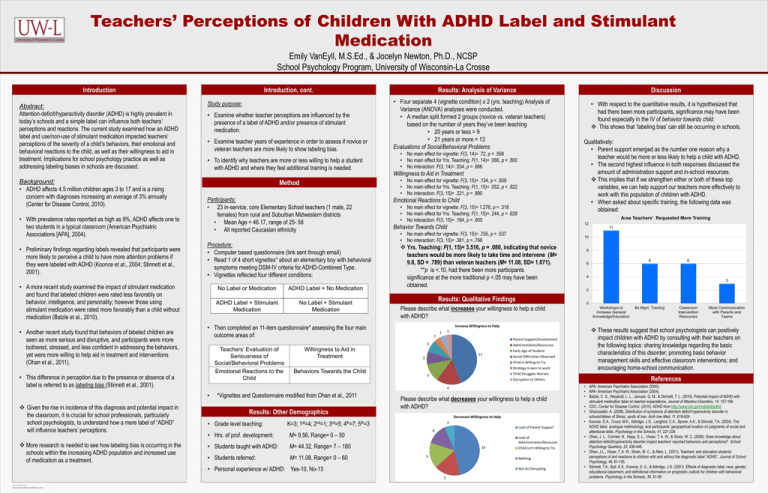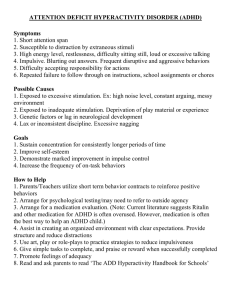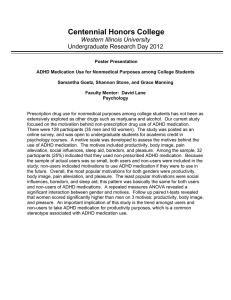Teachers’ Perceptions of Children With ADHD Label and Stimulant Medication
advertisement

Teachers’ Perceptions of Children With ADHD Label and Stimulant Medication Emily VanEyll, M.S.Ed., & Jocelyn Newton, Ph.D., NCSP School Psychology Program, University of Wisconsin-La Crosse Introduction Abstract: Attention-deficit/hyperactivity disorder (ADHD) is highly prevalent in today’s schools and a simple label can influence both teachers’ perceptions and reactions. The current study examined how an ADHD label and use/non-use of stimulant medication impacted teachers’ perceptions of the severity of a child’s behaviors, their emotional and behavioral reactions to the child, as well as their willingness to aid in treatment. Implications for school psychology practice as well as addressing labeling biases in schools are discussed. Background: • ADHD affects 4.5 million children ages 3 to 17 and is a rising concern with diagnoses increasing an average of 3% annually (Center for Disease Control, 2010). • With prevalence rates reported as high as 9%, ADHD affects one to two students in a typical classroom (American Psychiatric Associations [APA], 2004). • Preliminary findings regarding labels revealed that participants were more likely to perceive a child to have more attention problems if they were labeled with ADHD (Koonce et at., 2004; Stinnett et al., 2001). Introduction, cont. Study purpose: • Examine whether teacher perceptions are influenced by the presence of a label of ADHD and/or presence of stimulant medication. • Examine teacher years of experience in order to assess if novice or veteran teachers are more likely to show labeling bias. • To identify why teachers are more or less willing to help a student with ADHD and where they feel additional training is needed. Method Participants: • 23 in-service, core Elementary School teachers (1 male, 22 females) from rural and Suburban Midwestern districts • Mean Age = 46.17, range of 25- 58 • All reported Caucasian ethnicity Procedure: • Computer based questionnaire (link sent through email) • Read 1 of 4 short vignettes* about an elementary boy with behavioral symptoms meeting DSM-IV criteria for ADHD-Combined Type. • Vignettes reflected four different conditions: • A more recent study examined the impact of stimulant medication and found that labeled children were rated less favorably on behavior, intelligence, and personality; however those using stimulant medication were rated more favorably than a child without medication (Batzle et al., 2010). • Another recent study found that behaviors of labeled children are seen as more serious and disruptive, and participants were more bothered, stressed, and less confident in addressing the behaviors, yet were more willing to help aid in treatment and interventions (Ohan et al., 2011). No Label or Medication ADHD Label + Stimulant Medication Teachers’ Evaluation of Seriousness of Social/Behavioral Problems Emotional Reactions to the Child • No main effect for vignette: F(3, 14)= .72, p = .556 • No main effect for Yrs. Teaching: F(1, 14)= .066, p = .800 • No interaction: F(3, 14)= .534, p = .666 Willingness to Aid in Treatment • No main effect for vignette: F(3, 15)= .134, p = .939 • No main effect for Yrs. Teaching: F(1, 15)= .052, p = .822 • No interaction: F(3, 15)= .221, p = .880 Emotional Reactions to Child • No main effect for vignette: F(3, 15)= 1.276, p = .318 • No main effect for Yrs. Teaching: F(1, 15)= .244, p = .629 • No interaction: F(3, 15)= .184, p = .905 • No main effect for vignette: F(3, 15)= .755, p = .537 • No interaction: F(3, 15)= .381, p = .768 Results: Qualitative Findings Please describe what increases your willingness to help a child with ADHD? Increase Willingness to Help 1 1 1 Parent Support/Involvement Administration/Resources 11 2 Early Age of Student Social Difficulties Observed Strategy is seen to work Child Struggles Worsen 3 Disruption to Others *Vignettes and Questionnaire modified from Ohan et al., 2011 Results: Other Demographics • Grade level teaching: Please describe what decreases your willingness to help a child with ADHD? Decreases Willingness to Help K=3; 1st=4; 2nd=1; 3rd=5; 4th=7; 5th=3 • Hrs. of prof. development: M= 9.56, Range= 0 – 50 • Students taught with ADHD: M= 44.32, Range= 7 – 180 • Students referred: M= 11.08, Range= 0 – 60 8 6 6 6 4 3 2 2 Lack of Parent Support 4 14 5 Lack of Administration/Resouces Child Isn't Willing to Try Nothing Not As Disrupting 5 www.PosterPresentations.com 10 Yrs. Teaching: F(1, 15)= 3.516, p = .080, indicating that novice teachers would be more likely to take time and intervene (M= 9.8, SD = .789) than veteran teachers (M= 11.08, SD= 1.071). **p is <.10, had there been more participants significance at the more traditional p <.05 may have been obtained. • Personal experience w/ ADHD: Yes-10, No-13 TEMPLATE DESIGN © 2007 11 Child is Willing to Try Behaviors Towards the Child Qualitatively: • Parent support emerged as the number one reason why a teacher would be more or less likely to help a child with ADHD. • The second highest influence in both responses discussed the amount of administration support and in-school resources. This implies that if we strengthen either or both of these top variables, we can help support our teachers more effectively to work with this population of children with ADHD. • When asked about specific training, the following data was obtained: 12 Behavior Towards Child 2 Willingness to Aid in Treatment • With respect to the quantitative results, it is hypothesized that had there been more participants, significance may have been found especially in the IV of behavior towards child. This shows that ‘labeling bias’ can still be occurring in schools. Area Teachers’ Requested More Training 4 • More research is needed to see how labeling bias is occurring in the schools within the increasing ADHD population and increased use of medication as a treatment. No Label + Stimulant Medication Discussion • Four separate 4 (vignette condition) x 2 (yrs. teaching) Analysis of Variance (ANOVA) analyses were conducted. • A median split formed 2 groups (novice vs. veteran teachers) based on the number of years they’ve been teaching • 20 years or less = 9 • 21 years or more = 13 Evaluations of Social/Behavioral Problems • Then completed an 11-item questionnaire* assessing the four main outcome areas of: • This difference in perception due to the presence or absence of a label is referred to as labeling bias (Stinnett et al., 2001). Given the rise in incidence of this diagnosis and potential impact in the classroom, it is crucial for school professionals, particularly school psychologists, to understand how a mere label of “ADHD” will influence teachers’ perceptions. ADHD Label + No Medication Results: Analysis of Variance 0 Workshops to Increase General Knowledge/Education Bx Mgnt. Training Classroom Intervention Resources More Communication with Parents and Teams These results suggest that school psychologists can positively impact children with ADHD by consulting with their teachers on the following topics: sharing knowledge regarding the basic characteristics of this disorder; promoting basic behavior management skills and effective classroom interventions; and encouraging home-school communication. References • APA- American Psychiatric Association (2000). • APA- American Psychiatric Association (2004). • Batzle, C. S., Weyandt, L. L., Janusis, G. M., & DeVietti, T. L. (2010). Potential impact of ADHD with stimulant medication label on teacher expectations. Journal of Attention Disorders, 14, 157-166. • CDC- Center for Disease Control. (2010). ADHD from http://www.cdc.gov/ncbddd/adhd/ • Ghanizadeh, A. (2008). Distribution of symptoms of attention deficit-hyperactivity disorder in schoolchildren of Shiraz, south of Iran. Arch Iran Med, 11, 618-624. • Koonce, D.A., Cruce, M.K., Aldridge, J.O., Langford, C.A., Sporer, A.K., & Stinnett, T.A. (2004). The ADHD label, analogue methodology, and participants’ geographical location on judgments of social and attentional skills. Psychology in the Schools, 41, 221-234 • Ohan, J. L., Cormier, N., Hepp, S. L., Visser, T. A. W., & Strain, M. C. (2008). Does knowledge about attention-deficit/hyperactivity disorder impact teachers’ reported behaviors and perceptions? School Psychology Quarterly, 23, 436-449. • Ohan, J.L., Visser, T. A. W., Strain, M. C., & Allen, L. (2011). Teachers’ and education students’ perceptions of and reactions to children with and without the diagnostic label “ADHD”. Journal of School Psychology, 49, 81-105. • Stinnett, T.A., Bull, K.S., Koonce, D. A., & Aldridge, J.O. (2001). Effects of diagnostic label, race, gender, educational placement, and definitional information on prognostic outlook for children with behavioral problems. Psychology in the Schools, 36, 51-59






